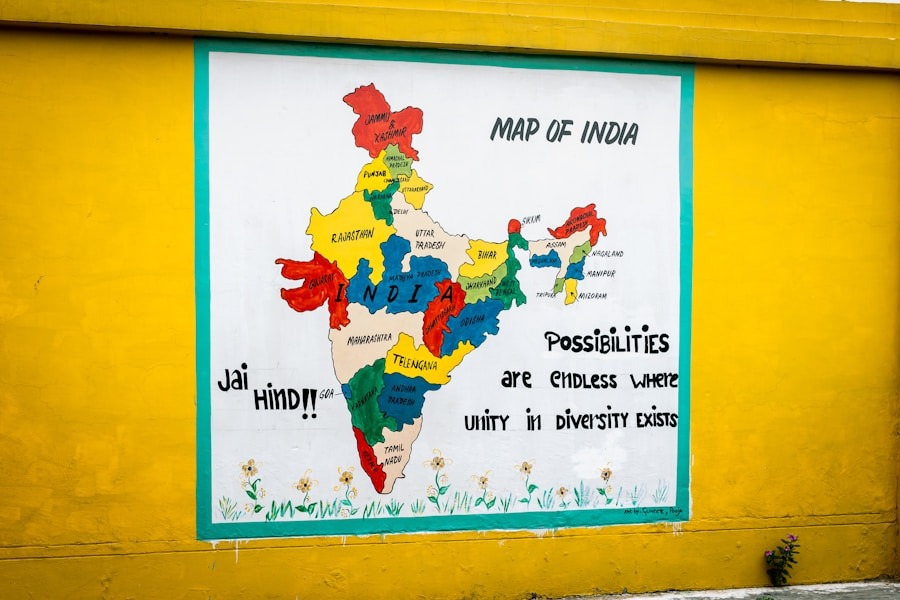Cross-border cooperation refers to the collaborative efforts between neighboring countries to address shared challenges, enhance mutual benefits, and foster regional stability. This form of cooperation can manifest in various domains, including trade, security, environmental management, and cultural exchange. In an increasingly interconnected world, the significance of cross-border cooperation has grown, as nations recognize that many issues transcend national boundaries.
From combating climate change to managing migration flows, the need for collaborative frameworks has never been more pressing. In the context of South Asia, cross-border cooperation is particularly vital due to the region’s complex geopolitical landscape. Countries like India, Pakistan, Bangladesh, Nepal, Bhutan, and Sri Lanka share not only borders but also a rich tapestry of cultural and historical ties.
However, these relationships are often marred by political tensions and historical grievances.
The potential for collaboration exists in various sectors, including trade agreements, joint infrastructure projects, and cooperative security arrangements, all of which can contribute to a more stable and prosperous South Asia.
Key Takeaways
- Cross-border cooperation is essential for fostering positive relations and addressing common challenges between neighboring countries.
- India’s approach to diplomacy emphasizes building strong relationships with neighboring countries through dialogue, trade, and cultural exchanges.
- Cross-border cooperation is important for India as it helps in addressing security concerns, promoting economic growth, and enhancing regional stability.
- Challenges in cross-border cooperation include political tensions, border disputes, and security concerns, while opportunities include increased trade, cultural exchange, and joint infrastructure projects.
- Case studies of successful cross-border cooperation, such as the Bangladesh-India land boundary agreement and the India-Nepal cooperation in hydropower projects, highlight the benefits of collaboration for mutual development and prosperity.
- The future prospects for India’s diplomatic engagement in cross-border cooperation look promising, with opportunities for increased connectivity, trade, and people-to-people exchanges in the region.
India’s Approach to Diplomacy
India’s approach to diplomacy has evolved significantly over the decades, shaped by its historical experiences and contemporary global dynamics. Traditionally characterized by a non-aligned stance during the Cold War, India has gradually embraced a more proactive foreign policy that seeks to engage with multiple global powers while maintaining its sovereignty. This shift is evident in India’s increasing participation in multilateral forums such as the United Nations, BRICS, and the Shanghai Cooperation Organization (SCO).
The country has also sought to strengthen its bilateral relations with key nations across the globe, recognizing that strategic partnerships are essential for addressing both regional and global challenges. In recent years, India’s diplomatic strategy has placed a strong emphasis on regional cooperation, particularly within South Asia. The “Neighborhood First” policy underscores India’s commitment to fostering closer ties with its immediate neighbors through economic collaboration, cultural exchanges, and security partnerships.
This approach is not only about enhancing India’s influence in the region but also about addressing common challenges such as terrorism, climate change, and economic development. By prioritizing cross-border cooperation, India aims to create a more stable and prosperous neighborhood that can collectively tackle issues that affect all countries involved.
Importance of Cross-Border Cooperation for India

Cross-border cooperation holds immense importance for India on multiple fronts. Economically, enhanced collaboration with neighboring countries can lead to increased trade and investment opportunities. For instance, India shares borders with several countries that have significant economic potential.
By fostering trade agreements and reducing barriers to commerce, India can tap into new markets and create a more integrated regional economy. The South Asian Free Trade Area (SAFTA) agreement exemplifies this potential, as it aims to promote trade among member states by reducing tariffs and facilitating smoother trade flows. Moreover, cross-border cooperation is crucial for addressing security concerns that transcend national borders.
India faces various security challenges, including terrorism and organized crime, which often have cross-border dimensions. Collaborative efforts in intelligence sharing, joint military exercises, and counter-terrorism initiatives can significantly enhance regional security. For example, the establishment of the South Asian Association for Regional Cooperation (SAARC) has provided a platform for member states to discuss security issues and develop cooperative strategies.
By working together on these fronts, India and its neighbors can create a safer environment conducive to economic growth and social stability.
Challenges and Opportunities in Cross-Border Cooperation
Despite the clear benefits of cross-border cooperation, several challenges hinder its effective implementation in South Asia. One of the most significant obstacles is the historical animosities and political tensions that exist between countries in the region. For instance, the longstanding conflict between India and Pakistan over Kashmir has created an atmosphere of distrust that complicates efforts at collaboration.
Such geopolitical rivalries often overshadow potential areas of cooperation, making it difficult for nations to engage meaningfully on shared issues. Additionally, bureaucratic hurdles and differing political priorities can impede progress in cross-border initiatives. Each country has its own set of regulations and policies that may not align with those of its neighbors.
This lack of harmonization can create barriers to trade and investment, stifling economic growth opportunities. However, these challenges also present opportunities for innovative diplomatic solutions. By engaging in dialogue and negotiation, countries can work towards resolving disputes and finding common ground on contentious issues.
Initiatives such as track-two diplomacy—informal dialogues between non-governmental actors—can help build trust and pave the way for more formal agreements.
Case Studies of Successful Cross-Border Cooperation
Several case studies illustrate the potential for successful cross-border cooperation in South Asia. One notable example is the India-Bangladesh relationship concerning water resource management. The Ganges River Treaty signed in 1996 established a framework for sharing water resources between the two countries during the dry season.
This agreement has not only helped mitigate water scarcity issues but has also fostered goodwill between the nations. Joint management of shared rivers demonstrates how collaborative approaches can lead to sustainable resource utilization while strengthening diplomatic ties.
The two countries have engaged in various projects aimed at enhancing connectivity through road and rail networks. The recent inauguration of the Kathmandu-India railway line exemplifies this partnership’s success in improving trade links and facilitating people-to-people connections. Such infrastructure projects not only boost economic activity but also reinforce cultural ties between the two nations, showcasing how cross-border cooperation can yield tangible benefits for both parties.
Future Prospects for India’s Diplomatic Engagement in Cross-Border Cooperation

Looking ahead, the prospects for India’s diplomatic engagement in cross-border cooperation appear promising yet complex. As global dynamics shift and new challenges emerge—such as climate change, pandemics, and cybersecurity—India’s role as a regional leader will be increasingly critical. The country must navigate its relationships with neighboring states carefully while promoting collaborative frameworks that address these shared challenges.
Furthermore, India’s growing economic clout presents an opportunity to leverage its influence for regional stability. By investing in infrastructure projects and fostering trade relationships with its neighbors, India can create a more interconnected South Asia that benefits all parties involved. Initiatives like the International Solar Alliance highlight India’s commitment to addressing global challenges through cooperative efforts with neighboring countries.
In conclusion, while challenges remain in fostering cross-border cooperation in South Asia, the potential benefits are substantial. By prioritizing diplomatic engagement and collaborative initiatives, India can play a pivotal role in shaping a more stable and prosperous region. The future of cross-border cooperation will depend on India’s ability to build trust with its neighbors while addressing shared challenges through innovative solutions and sustained dialogue.
Cross-Border Cooperation and India’s Diplomacy is crucial for fostering strong international relationships. In a related article on Are Fruits Good for Diabetes?, the importance of maintaining a healthy lifestyle is highlighted, which can also contribute to successful diplomatic efforts. By understanding the basic concepts of karma and freedom of choice as discussed in The Gita, individuals can make informed decisions that benefit not only themselves but also their communities through cross-border cooperation. Additionally, recognizing different types of bifurcation, as explained in Understanding Bifurcation: Types and Examples, can help in navigating complex diplomatic situations and finding common ground for cooperation.
FAQs
What is cross-border cooperation?
Cross-border cooperation refers to the collaboration and coordination between different countries or regions that share a common border. This cooperation can involve various aspects such as trade, security, environmental protection, and cultural exchange.
Why is cross-border cooperation important for India’s diplomacy?
Cross-border cooperation is important for India’s diplomacy as it helps in building and maintaining good relations with neighboring countries. It also facilitates economic growth, enhances security, and promotes regional stability.
What are some examples of cross-border cooperation initiatives undertaken by India?
India has undertaken various cross-border cooperation initiatives, such as the South Asian Association for Regional Cooperation (SAARC), the Bangladesh-Bhutan-India-Nepal (BBIN) Initiative, and the Mekong-Ganga Cooperation. These initiatives aim to promote regional integration, economic development, and cultural exchange.
How does cross-border cooperation benefit India?
Cross-border cooperation benefits India by promoting trade and investment, enhancing security and stability in the region, and fostering cultural and people-to-people exchanges. It also helps in addressing common challenges such as climate change, terrorism, and transnational crime.
What are the challenges in cross-border cooperation for India?
Challenges in cross-border cooperation for India include historical conflicts and disputes with neighboring countries, border security issues, and differing political and economic priorities among the participating countries. Overcoming these challenges requires diplomatic efforts and mutual understanding.






















+ There are no comments
Add yours